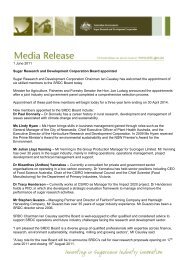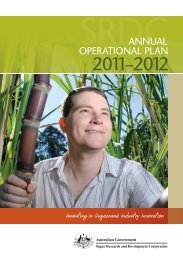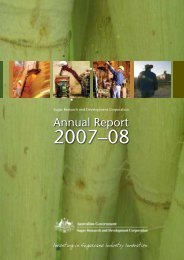Section 2 - Sugar Research and Development Corporation
Section 2 - Sugar Research and Development Corporation
Section 2 - Sugar Research and Development Corporation
You also want an ePaper? Increase the reach of your titles
YUMPU automatically turns print PDFs into web optimized ePapers that Google loves.
The total area planted using zonal tillage<br />
increased from 30 ha in 2007 to 2500 ha in 2009<br />
<strong>and</strong> the number of growers adopting the practice<br />
increased from fi ve in 2007 to 100 in 2009.<br />
Trial data showed that all cultivation treatment<br />
produced good yields in the right conditions<br />
with similar yields being attained with all<br />
treatments over a range of trial sites <strong>and</strong> a<br />
saving of $400/ha made.<br />
The economic benefi t of the system comes<br />
through maintaining cane yields while reducing<br />
input costs (BSS306).<br />
SmutBuster: Accelerated breeding of smutresistant<br />
sugarcane varieties<br />
The SmutBuster project uses high breeding value<br />
parental germplasm with susceptible reaction<br />
to smut to provide a wider choice of more<br />
productive smut-resistant cane varieties.<br />
More productive varieties require less resource<br />
inputs <strong>and</strong> plough-out resulting in positive<br />
environmental <strong>and</strong> social benefi ts.<br />
SmutBuster should also improve the rate<br />
of genetic gain for tonnes sugar/ha/year<br />
The shorter parent generation interval practised<br />
in SmutBuster will dramatically increase the<br />
frequency of smut resistant genes in the parent<br />
populations.<br />
The SmutBuster selection program is only<br />
mid-way to completion <strong>and</strong> no commercial<br />
sugarcane varieties have been released within the<br />
time-frame of this project. The fi rst commercial<br />
varieties from SmutBuster are expected to be<br />
released to the industry in 2016 (BSS325).<br />
Integrated nutgrass control in NSW<br />
Nutgrass is a particular problem in the cane<br />
growing areas of northern NSW causing poor<br />
germination <strong>and</strong> reduced growth of young<br />
plants <strong>and</strong> ratoon crops. Previous attempts to<br />
control outbreaks were ad hoc with no structured<br />
package available for satisfactory control.<br />
REGIONAL FUTURES<br />
The trial work <strong>and</strong> economic analysis of this<br />
project showed a substantial economic benefi t<br />
for growers was achievable from controlling<br />
nutgrass in cane by adopting a long-term<br />
integrated approach to reduce the number<br />
of viable tubers.<br />
A publication, ‘Managing Nutgrass in Cane’,<br />
was produced for growers (NFS002).<br />
Harnessing soil biology to improve the<br />
productivity of the new sugarcane farming<br />
system<br />
This project addressed how management affects<br />
soil biological processes. The fi rst project phase<br />
assessed how the ‘new sugarcane farming<br />
system’ (reduced tillage, legume break crop,<br />
trash blanketing, <strong>and</strong> reduced nitrogen (N)<br />
fertiliser application), impacts on N cycling<br />
<strong>and</strong> soil biological processes.<br />
<strong>Sugar</strong>cane soils in north <strong>and</strong> southern<br />
Queensl<strong>and</strong>, including the Yield Decline Joint<br />
Venture site in Ingham <strong>and</strong> two commercial<br />
farms with contrasting management practices<br />
in Bundaberg, were used for this research.<br />
A special focus was the development <strong>and</strong><br />
application of novel molecular techniques<br />
to monitor soil microbial function for analysis<br />
of soil processes.<br />
Outcomes of the technical advances are that<br />
comprehensive analysis of microbial function<br />
is possible for unprecedented insight into soil<br />
biological processes. The results show that<br />
management affects soil microbial biomass<br />
as well as composition <strong>and</strong> function of the<br />
microbial community. However, the identifi ed<br />
differences between farming systems were<br />
mostly short-lived <strong>and</strong> had little or no effect on<br />
the overall availability of N, N cycling, N losses<br />
<strong>and</strong> sugarcane yield. The fi ndings support the<br />
notion that lower N input is not detrimental to<br />
sugarcane yield but may reduce environmental<br />
impacts. The results also show that additional<br />
improvements of the new farming system are<br />
necessary to synchronise N availability <strong>and</strong> crop<br />
N dem<strong>and</strong>. Production of mobile forms of N,<br />
especially nitrate, but also the generation of<br />
greenhouse gases, have to be improved.<br />
SRDC Annual Report 2010–2011 53






